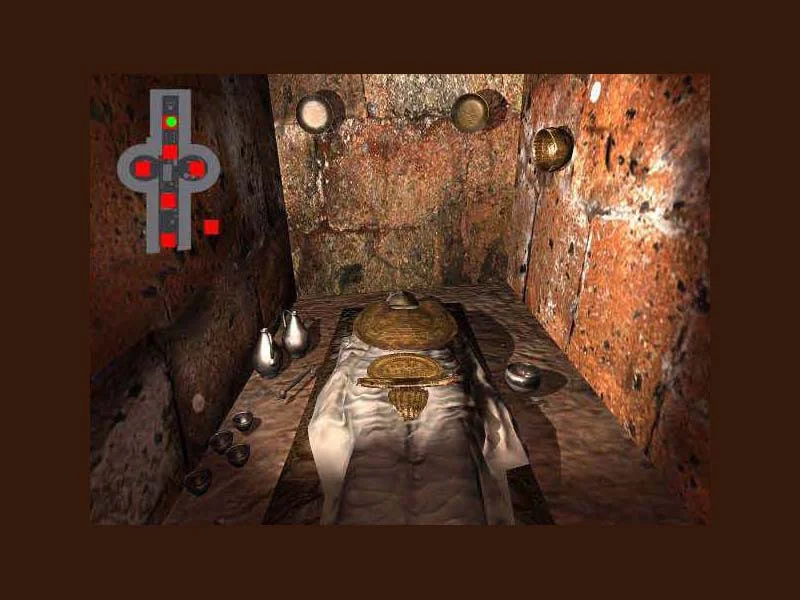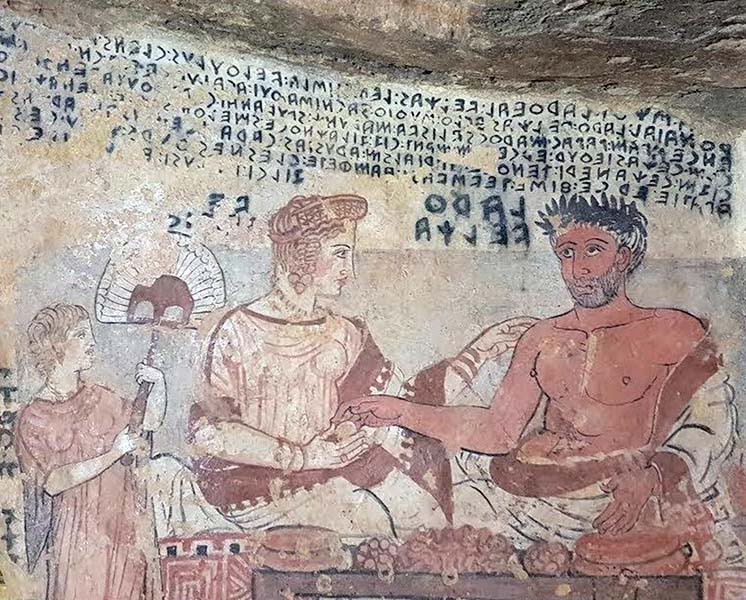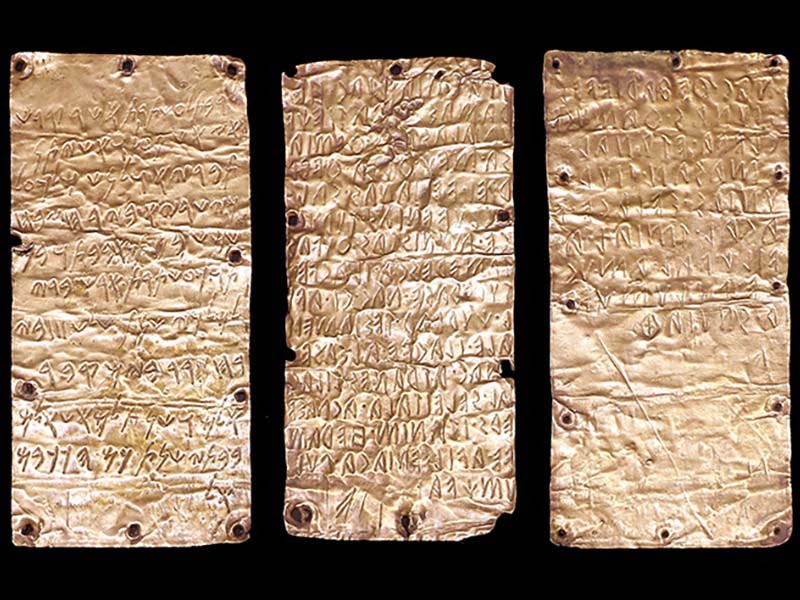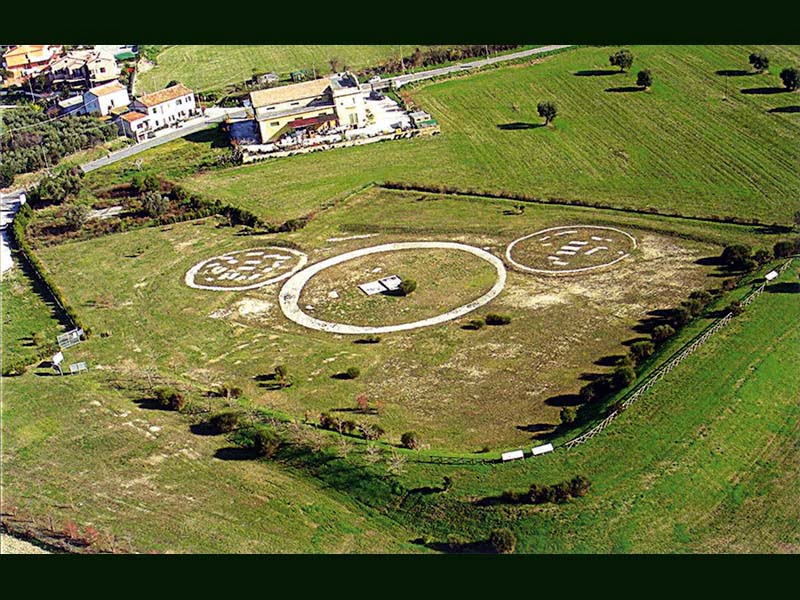di Julia Goggi
The condition of the Etruscan woman seems to have been freer than that of contemporary women. It has been hypothesized that they knew how to write and read and the inscriptions on some mirrors could be related to this, explaining the scenes represented.
The mother's name or matronymic often appears in Etruscan inscriptions: it is thought that the origin of the bimembre onomastic system is Etruscan. This system also appears in the Latin and Italic world and is characterized by the use of the personal name and the noble or family name; the innovative thing is the presence, next to the two main elements, of the patronymic and matronymic, therefore also of the mother's name.
This element in particular made us think that the position of the Etruscan woman was not subordinated like the Greek one: in fact, the former was not denied participation in banquets alongside the men, that is, lying down next to them.
A habit that greatly scandalized Greek historians who were certainly not used to seeing Greek women participate in banquets in that position if not in the role of prostitutes; this custom, which Riane Eisler mentions, “[…] is an external indication of social equality, which also for this aspect reconnects the society of the ancient Etruscans to customs of the western and modern world“. A sign of society's consideration for the Etruscan woman. Eisler's hypothesis is that the Etruscans, for whom she points out a similarity with the art of Minoan Crete, practiced the matrilineal descent that she hypothesizes was in use for the periods preceding the descent of the Kurgan proto-Indo-European peoples.
Theopompus in the XNUMXth century BC. C. complains about the debauchery of the Etruscan women who feasted lying next to their husbands and who could even drink wine and complains that they had too permissive a sexuality. The sources tell of the aforementioned Tanaquilla, wife of Tarquinio Prisco: who, according to Livio[1], had played an active role in her husband's political rise, held religious and spiritual powers and was said to assist her husband in managing political power.
This aspect had cost the Etruscans a lot of criticism from contemporary ancient sources, in particular from the Greek ones, who pointed out that Etruscan women behaved inappropriately to their status (that is, their gender), therefore not knowing how to keep their place. In the Athens of the fifth century BC, according to Eva Keuls (who based herself on the vase paintings with scenes of daily life in Athens, on the laws and on the sources) in democratic Athens "phallicism" was in force which relates to a strict regulation of sexuality feminine: “a combination of male supremacy and the cult of the power of violence”.
Role indicators and gender indicators
They are objects whose function is loaded with symbolic values, which gave the owner/a social and economic power and attributing aspects of aristocratic ideology to the burial.
Of the elements of the wagon, the metal parts are generally found (rims and parts of the rudder and/or horse bits): for this reason in most cases it was not possible to define the type of wagon. Examples of it are known in female burials as early as the first half of the eighth century BC. C.: two-wheeled chariots (therefore for transport) are also known in Central Europe already between the XNUMXth and XNUMXth centuries (Culture of Hallstatt CD), these burials have been attributed to the wives of chiefs[2] even if it cannot be excluded that they themselves could play a role of power (at least as priestesses).
In the mid-Adriatic area there are several examples of deposition of carts in tombs also rich in ornaments and vascular elements. This may suggest that they may be princesses who exercised the role of priestesses, being aware of haruspicy practices.
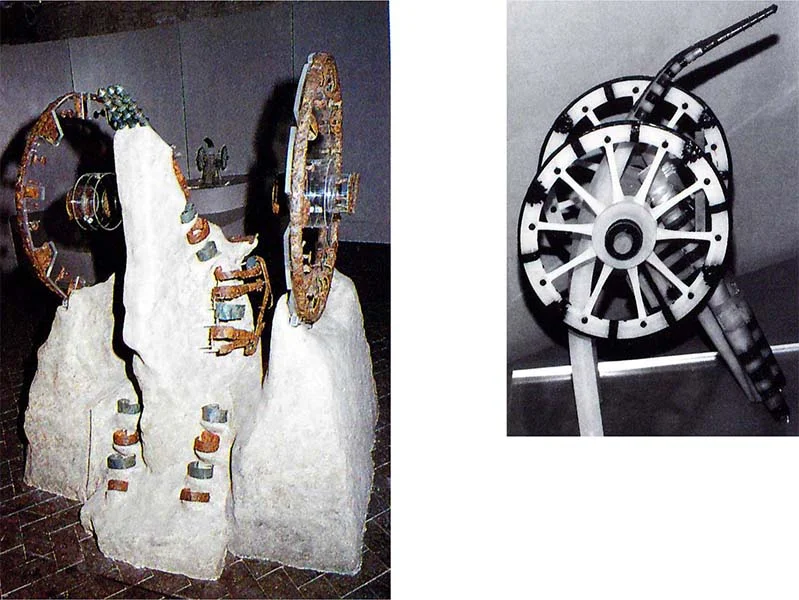
Even more controversial are the deposits of weapons in female burials[3]. Generally they are parade shields, therefore not to be used in battle but purely as a "figure". The lack of remains and documentation often does not help to understand their exact position, but it has been hypothesized that they were leaned vertically against the walls of the pits. It seems that the intent was to imitate the rich houses in which the deceased lived: the tradition of decorating the walls of aristocratic houses with parade shields is documented. Perhaps the intention was to underline the aristocratic status of the deceased and her role as wife of a boss or holder of power, but it could also indicate the fact that the woman herself held an important role in society.
Another class of objects that is interesting from this point of view belongs to gender markers, in particular to spinning and weaving objects. Some of these are distinguished by the material they are made of which makes it difficult to think of their practical use in spinning. Spindles and distaffs are frequent objects in the female tombs of Etruria, Piceno and Veneto between the eighth and seventh centuries[4]; in tomb 17 in the locality of Monte Penna di Pitino San Severino, iron rods with nodules were also found with bronze elements evoking the Cretan Venus pudica, interpreted as a distaff/sceptre, therefore as an object of power representing the priority role of women in management of textile activities[5].
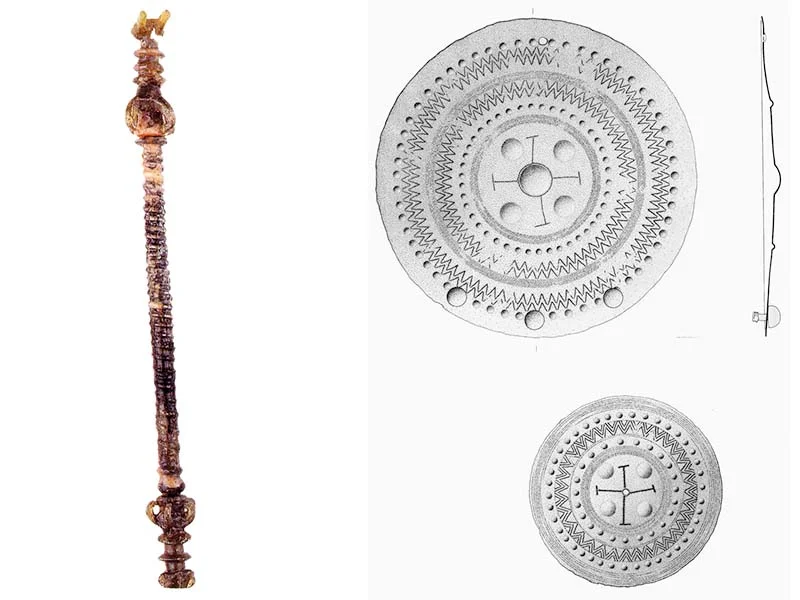
For these objects, distinctive of women (it was they who knew how to weave and spin, as we also read fromOdyssey about Circe[6], Calypso[7] and Penelope), it is possible to think of a representative function given that the material does not allow them to be used for spinning and weaving: Raffaella Papi speaks of "scepters", or "spindle-sceptre", insisting on the economic-social importance of weaving and the role played by women in domestic work; Marina Martelli, Gilda Bartoloni and Miria Roghi state that these types of objects could be distaffs made of material whose preciousness and fragility represent the status of the deceased[8].
Ramatha Spesias and the politics of Caere
The tomb of the Graffite Inscriptions at the Banditaccia necropolis in Cerveteri was discovered in August 1981 during a clandestine excavation. Its peculiarity and the name come precisely from the fact that it is currently one of the few examples in Etruria (and the only one in Cerveteri) to have graffitied inscriptions and not painted or engraved; moreover it is one of the few examples of archaic inscriptions in Etruria (except the complexes of Portonaccio and Pyrgi) and the one with the most complete inscriptions (the tomb of painted inscriptions of Tarquinia does not even have 10 words).
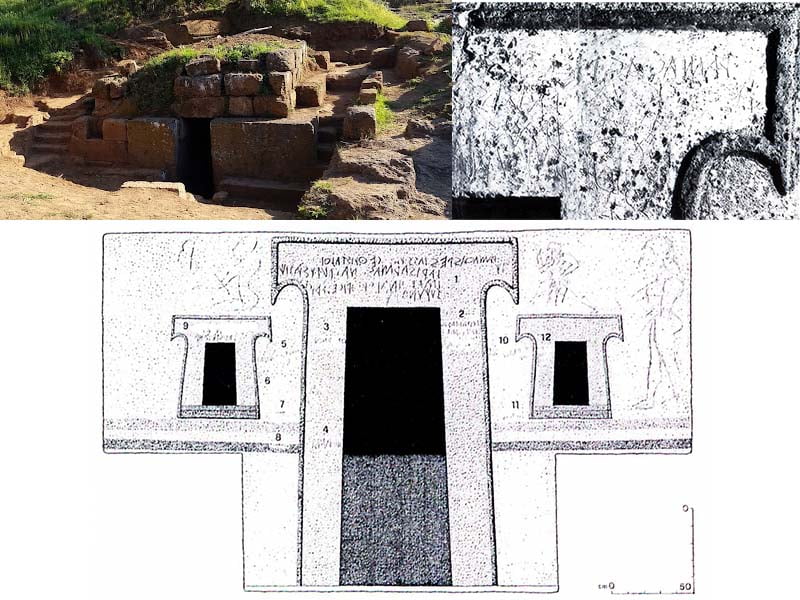
The tomb is dated around 530-515 BC. C. and represented a turning point in research not only because it increased our knowledge of the Etruscan lexicon, but above all because it allowed us to make more in-depth reflections on the best known figure of the Etruscan political landscape of the sixth century BC. C. and on his genealogy: Thefarie Velianas; moreover, it highlighted the role that an Etruscan woman could play in the politics of the cities.
The longest of the many inscriptions appears to be a sacral inauguration or rite performed in favor of the deceased; here the name Ramatha Spesias appears in the first line, the subject of a sentence whose verb is in the past tense (sχạ [ni] ce) followed by a locative locution that would indicate the tomb itself (𐌉𐌞𐌈: thui: here), followed by stalthi (𐌉𐌈𐌋𐌀𐌕𐌔 ): this made it possible to translate the inscription as “in the [tomb] of the sta”. Along with Ramatha, other people are named who perform actions (“write, prescribe”) and are indicated by attributes and adjectives (“one who makes offerings to the gods”); among these appears the beneficiary of the shares, which would be the man named Larice Veliinas. The noble family has been associated with that of the plates of Pyrgi: Thefarie Velianas author of the plates and of the dedication of Temple B of the Sanctuary.
Given the central position of the name in the sentence and in the tomb, it has been assumed that it was the deceased for whom the tomb was intended and that he died around 530-520 BC. C. or in any case not after that date. Based on this it was assumed[9] that Larice and Ramatha were the parents of Thefarie, who became "lord" of Caere about three years before the dedication of the plates (which took place in 510 BC).
Considering that Thefarie's name does not appear in any of the inscriptions, it has been suggested that his role was fulfilled by Ramatha, probably his mother and widow of the deceased. After Larice's death and once the burial and celebration rites had been completed, Thefarie was able to reach probably the highest political office within the honorum course cerite.
It seems probable that Ramatha Spesias had an important role, not only as guide of the rite dedicated to the deceased of the tomb, but probably also as advocate of the rise to power of her son and for this reason she is entrusted with an important role in the burial ritual: not both as a wife and as a supporter of the rise to power of the new "lord".
Conclusions
Annette Rathje hypothesizes that in Etruria religious power was exercised by the princesses[10]. This hypothesis can be confirmed precisely by archaeological and literary evidence. Objects such as those found may have had the purpose of indicating the holders as regents or supporters of a political power or as holders of a religious power. It is probable that women held prominent roles in the community: as in the case of Tanaquilla, wife of Tarquinio Prisco, for whom the role of "regent" during the succession to Servius Tullus has been hypothesized; that probably as a priestess, she could drive the chariot (a privilege that in Rome was granted only to the Vestals)[11]. It is therefore possible to think that Ramatha Spesias had played an active part in the transfer of power from Larice Veliinas to Thefarie Velianas.
For Etruria in the Orientalizing period it has been assumed that the woman covered the role of "progenitor and guarantor of the continuity of the group and of the lineage, within the ambit of a probable system of bilinear descent, for some women of the aristocracy as custodians of particular powers and prerogatives"[12] in spaces that go far beyond just the domestic environment and concern the sacred and cults. Therefore, there has been talk of an "epiphany of the queen and the goddess" through the very figure of Tanaquilla also for the woman buried in the Regolini-Galassi Tomb in Cerveteri. Tomb attributed to a woman of the highest rank, progenitor of a noble group and accompanied by a single family member buried in a more sober and hermetically closed side cell and with more sober equipment[13]. Other similar cases are the tomb 2465 of Pontecagnano[14] and the Tomb of the Trident of Vetulonia[15].
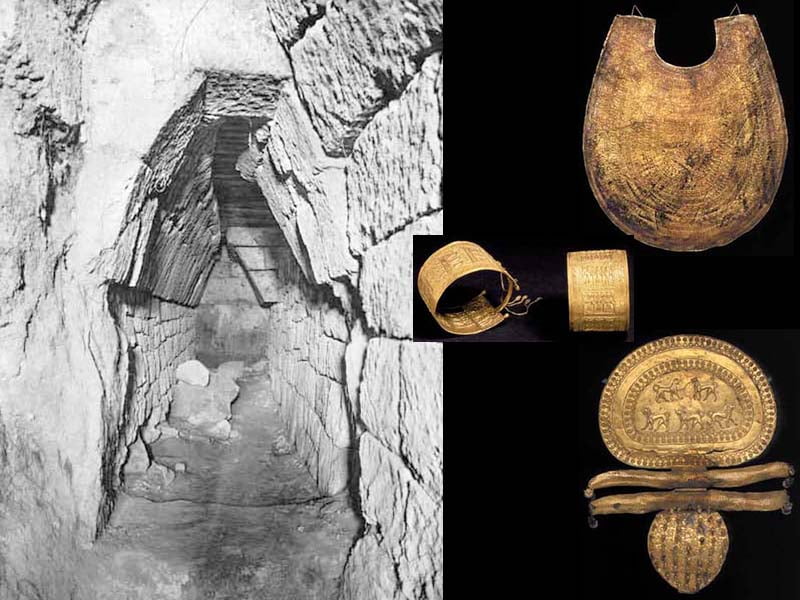
Even outside the Etruscan environment some evidence has been recognized which has led to the definition of prestigious female depositions through indicators of a sacral and ritual type (axes, axes, knives, spits) or indicators of rank (horse bits, ceramic or metal ceremonial type): objects that are clues to prerogatives that prefigure a wide range of powers.
Anna Maria Bietti Sestrieri in one of her contributions from 2009 enhances the roles of female power in the sacral sphere and in the production of ceramics by analyzing the necropolis of Osteria dell'Osa for the Lazio II period (late X-IX century BC). The hypotheses in the archaeological field have been accompanied by a careful anthropological analysis which has allowed a verification of the distinctions by age group. In this necropolis a series of prerogatives have been identified as a clear manifestation of power: some specificities in the treatment of the body, the presence in the pottery of objects with ritual significance or attributes such as the meat knife (instrument connected to sacrifice and to divinity). This has allowed us to hypothesize that the women buried in these burials were priestesses[16].
A social importance attributed to women that seems to be recognized also in Homer, and also recalled by Momolina Marconi: "So the social life in Homer, and I refer to the precious studies of Patroni, continues by custom to recognize the superiority of women, even of the Woman with a capital letter […]”[17]. And presumably it is not a reference to the Amazons, since there are probably no communities of women dedicated to war[18].
It is quite certain that women in the communities of the Orientalizing Mediterranean and beyond were entrusted with a rather important role. And it is probable that at least the depositions with chariots (as for example the tomb of the Queen of Sirolo-Numana), those with weapons or those with particular objects of power were priestesses (or shamans) to whom socio-political power was also attributed in virtue of their abilities.
Giulia Goggi – May 2023
[1] Livy - The History of Rome – Book 34 – Chapter 39;
[2] Gilda Bartoloni – The societies of primitive Italy – Carocci – Rome – 2003 – p. 139;
[3] Gilda Bartoloni and Anna De Santis – “The deposition of shields in the tombs of the XNUMXth and XNUMXth century BC. C. in central Tyrrhenian Italy” – in Prehistory and protohistory in Etruria. Second study session – Milan – 1995 – pp. 278-287;
[4] Gilda Bartoloni, Alessandra Berardinetti and Luciana Drago - "The communities of the lower Tiber valley and the eastern Mediterranean before the Greek colonization" - in Die agais und das westliche Mittelmeer. Beziehungen und Wechselwirkungen 8. bis 5. Jh v. Chr Akten des Symposions (Wien 24-27 March 1999) - Vienna - pp. 525-533;
[5] Marina Silvestrini, Tummolesi Patrizia Sabbatini (edited by) – Power and splendor. The ancient Picenes in Matelica. Catalog of the exhibition (Matelica Palazzo Ottoni 19 April-31 October 2008) – Rome – 2008 – pp. 141-153;
[6] Homer – Odyssey - Book X – Line 210 and following;
[7] Homer – Odyssey - Book V;
[8] Gilda Bartoloni, Filippo Delpino, Cristiana Morigi Govi and Giuseppe Sassatelli (ed.), Etruscan princes between the Mediterranean and Europe, exhibition catalog – Venice – 2000 – p. 278;
[9] Giovanni Colonna - "News on Thefarie Velianas" - in Annals of the Claudio Faina Foundation – XIV – Orvieto – p. 9-24; Giovanni Colonna - "Magazine of Etruscan Epigraphy" - in Etruscan Studies – LXXI – Florence – 2007 – pp. 168-198;
[10] Annette Rathje – “Princesses” in Etruria and Latium? – in AA. VV. – Ancient Italy in its Mediterranean settings. Studies in honor of Ellen Macnamara – London – 2000 – pp. 285-300;
[11] Simona Rafanelli - "From Tanaquilla to Larthia Seianti: the Etruscan woman in public and private" - in C. Casi (edited by) - The woman in antiquity. Archeology and history of the condition of women from prehistory to the Middle Ages – Laurum Editrice – Pitigliano (GR) – 2016 – pp. 45-68;
[12] Giovanni Colonna – “News on Thefarie Velianas" - in Annals of the Claudio Faina Foundation – XIV – Orvieto – 2007 – p. 9-24;
[13] Giovanni Colonna and Elena Di Paolo - "The empty bed, the distribution of the grave goods and the "windows" of the Regolini-Galassi Tomb" - in Etruscan and Italic. Written in memory of Massimo Pallottino – Rome-Pisa – 1997 – pp. 131-172;
[14] Maria Assunta Cuozzo – Reinventing tradition – Paestum, 2003;
[15] Mario Cygielman and Lucia Pagnini – Vetulonia 2. The Tomb of the Trident of Vetulonia – Rome – 2006;
[16] Anna Maria Bietti Sestrieri – “Domi mansit, lanam fecit: Was That all? Women's Social Status and Roles in Early Latial Communities (IIth-9th BC)” – in Journal of Mediterranean Archaeology - 21 - I – 2009 – p. 133-159;
[17] Momolina Marconi - "From Circe to Morgana" - in Reports of the Royal Lombard Institute of Sciences and Letters – 1940-41 – collected in Anna De Nardis (edited by) – From Circe to Morgana. Writings by Momolina Marconi – Rome – 2009;
[18] Jeannine Davis-Kimball – Women Warriors. The Shamans of the Silk Road – Rome – 2009 (first ed. 2002) – p. 137.

